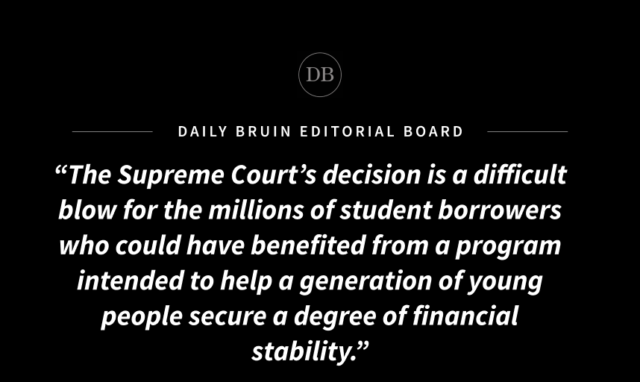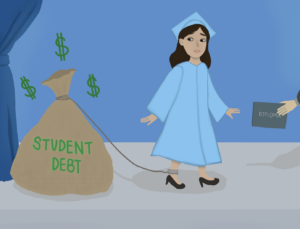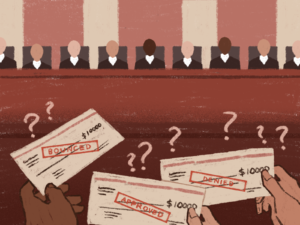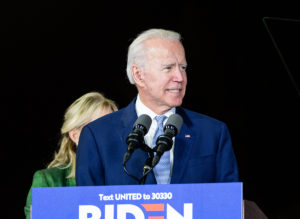This post was updated July 16 at 4:14 p.m.
Editor’s note: Editorials do not represent the Daily Bruin as a whole. The board encourages readers to respond to our editorials at dailybruin.com/submit.
The Supreme Court has issued yet another decision with far-reaching implications on the accessibility of college education.
On June 30, the Supreme Court announced its 6-3 ruling in Biden v. Nebraska, declaring President Joe Biden’s student loan debt forgiveness program unconstitutional. The program would have forgiven up to $10,000 in federal loans for student borrowers and up to $20,000 for Pell Grant recipients.
The suit against the debt cancellation program was brought by six states, including Nebraska, Missouri, Kansas, Arkansas, Iowa and South Carolina, who argued they would experience economic harm if the program was implemented. They specifically challenged the Biden administration’s use of the authority granted under the 2003 Higher Education Relief Opportunities for Students Act, which gives the Secretary of Education new powers over federal student loans during times of crisis, to cancel the debt.
Writing for the majority, Chief Justice John Roberts agreed with the reasoning provided by the states. The ruling was based, in part, on a formulation of the major questions doctrine, a conservative legal theory that has only gained prominence in the last two decades, which asserts that government agencies cannot make decisions on major policy questions without the explicit assent of Congress.
The Supreme Court’s decision is a difficult blow for the millions of student borrowers who could have benefited from a program intended to help a generation of young people secure a degree of financial stability.
It’s clear that the financial ramifications of the decision will be enormous for most student borrowers. Given the dire economic effects of the pandemic, along with the renewal of payments after being suspended for most of the pandemic, restarting payments will likely be highly disorganized and come with severe financial repercussions.
More than 7.5 million student borrowers who were in default on their loans, many of whom are first-generation and lower-income students, were granted a brief reprieve during the pandemic. In tandem with the Supreme Court’s ruling, the pause on student loan payments is set to expire Aug. 30 as part of the recent compromise bill Congress passed to raise the debt ceiling.
Because student loans cannot be shed in bankruptcy, borrowers will now be forced to pay by loan servicers, which can leverage the consequences of nonpayment on a borrower’s credit score or garnish up to 15% of their wages directly. This will all come at a time when the cost of living remains elevated and more companies are laying off workers.
Although the Biden administration has announced a program to help defaulted borrowers avoid loan collections, without greater support, the burden for borrowers will be immense.
The seemingly shaky grounds for the case against the student loan cancellation program, however, show that the decision’s faults extend beyond its consequences.
The first critical issue with the case relates to the legal concept of standing – whether a party has the right to sue. In this case, the six states that sued claimed they would be financially harmed by the decision, although none of them directly administer federal student loans.
In order for the states to get standing for the case, the state of Missouri sued on behalf of the Missouri Higher Education Loan Authority, a quasi-governmental loan servicing company in the state. Because the states had not been harmed directly by student debt relief, they needed MOHELA to support their claims that they were harmed by the Biden administration’s program.
However, while Missouri sued nominally because of MOHELA, the nonprofit itself was not a party to the lawsuit, and its employees strongly opposed their inclusion in the states’ case.
In a statement responding to Democratic Rep. Cori Bush, who represents Missouri’s 1st Congressional District, the nonprofit’s directors stated clearly that they had no role in the litigation, despite the state government building its case on the alleged harms MOHELA would experience.
Even more shocking, however, was the announcement of the findings of an analysis based on MOHELA’s financial data, conducted by the Roosevelt Institute and the Debt Collective. According to these organizations, their analysis found that, following the enactment of the debt relief plan, MOHELA’s revenues would actually increase from where they had been before the pandemic, in sharp contrast to what Missouri had alleged in the lawsuit.
On the other hand, the major questions doctrine, which also played a central role in the argument of the conservative justices, is also both very new and highly controversial.
At its core, this legal theory posits that federal agencies cannot act on issues of major significance without explicit congressional approval. In doing so, the justices have weaponized the ambiguous phrasing of legislation to impede any policy they deem incompatible with a narrow reading of how a law is phrased, without regard for the intent of lawmakers.
The legal questions surrounding the justices’ reasoning in this case, however, highlight how the Court’s deep politicization will remain a constant obstacle to political progress on many of the policy issues that shape the nation.
While the decision’s proponents have attacked Biden’s program as a handout to wealthy college graduates, this framing is far from the truth. The program explicitly limited itself to individuals with incomes of less than $125,000 annually or married couples jointly filing taxes who have a combined income of less than $250,000. About 40% of student debt holders, meanwhile, don’t have degrees, and over 60% lack four-year degrees.
To be clear, Biden’s student loan initiative certainly had its flaws. The Congressional Budget Office estimated the program would cost around $400 billion over the course of 30 years – an effort that clearly is unsustainable in the long run.
And, at its core, the program did little to ultimately address the root causes of the student loan debt crisis: the rising cost of tuition at American universities.
Since the decision, the Biden administration has announced a set of new policies to mitigate the decision’s effects, including an effort to develop a new debt relief plan based on the authority granted under the Higher Education Act.
As another legal battle over the fate of student debt relief is brewing, it’s clear that this issue requires systemic and profound solutions spanning the institutions of higher education all over the country.
Otherwise, we are lost.






Comments are closed.